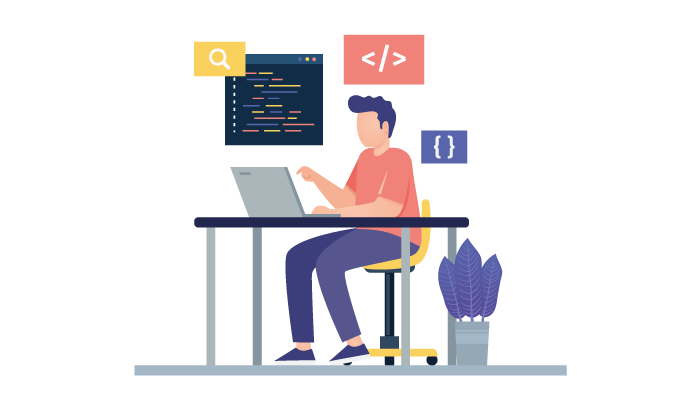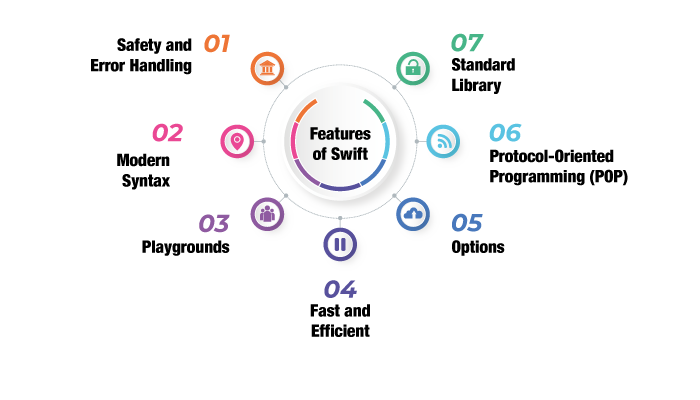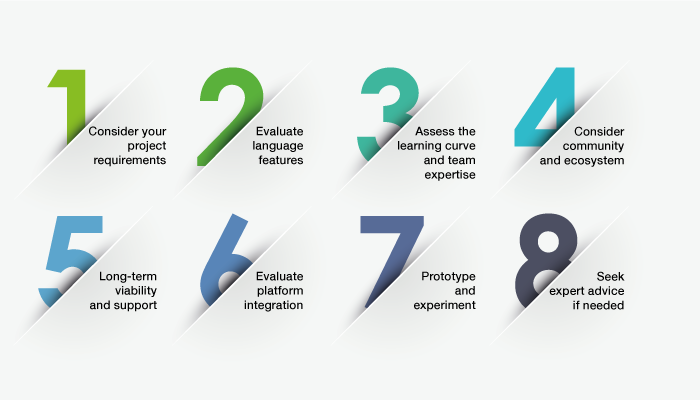Table of Contents
In recent years, iOS app development is growing quite popular. And this raises a big question, what’s better for creating an iOS app, Objective C vs Swift?
Both of these are amazing programming language that every developer love, making it that much harder of a choice. This is especially an issue for businesses and people who want to create an iOS for the first time.
If you are stuck with the same question in your mind, this blog is for you.
Here, we shall be discussing all you need to know about two of the best iOS app development languages, i.e. objective C and Swift.
We shall be going through their definition, features, pros, cons, and much more. Therefore, with this being said, let’s get right into it:
Objective C: OG Programming Language for iOS App Development

Let’s start with the older of the two in the objective C vs Swift debate.
Objective-C was the primary programming language for iOS app development before the introduction of Swift.
It was created by Brad Cox and Tom Love in the early 1980s and gained popularity with the release of NeXTSTEP, the predecessor to iOS and macOS.
Moreover, Objective-C is a superset of the C programming language, meaning that any valid C code is also valid Objective-C code. It adds object-oriented capabilities and dynamic runtime features to C, making it suitable for developing applications with graphical user interfaces (GUIs) and event-driven programming.
Moving on, let’s look at some of the top features of this programming language.
Features of Objective C
What provides leverage to this programming language when comparing objective C vs Swift is its feature. So, let’s go through them:
Object-Oriented Programming:
Objective-C supports the concepts of classes, objects, inheritance, and polymorphism, allowing developers to create complex object-oriented designs.
Dynamic Runtime
Objective-C’s dynamic runtime enables features like dynamic typing, late binding, and message passing between objects. This flexibility allows for powerful runtime introspection and modification of objects at runtime.
iOS and macOS Frameworks
Objective-C is the primary language used to develop the iOS and macOS frameworks. These frameworks provide a rich set of libraries and APIs for building applications, handling user interfaces, accessing device features, and more.
Interoperability
Objective-C can be mixed with C and C++ code within the same project. This feature allows developers to leverage existing C or C++ libraries in their Objective-C projects.
Tooling and Community
Objective-C has a mature ecosystem with extensive documentation, libraries, and tools. Xcode, the official integrated development environment (IDE) for iOS and macOS, provides robust support for Objective-C development.
Objective C, Pros & Cons

With features out of the way, let’s look at the advantages and disadvantages of objective C in the section below:
Pros:
- Compatibility: This programming language is compatible with C and C++ code, allowing developers to leverage existing libraries and codebases written in these languages. It also provides interoperability with Swift, enabling a gradual migration from Objective-C to Swift.
- Mature Ecosystem: Objective-C has a vast and mature ecosystem with extensive documentation, libraries, and tools. This makes it easier to find resources, get support, and utilize third-party libraries for various functionalities.
- Dynamic Runtime: IT is dynamic runtime that enables features like dynamic typing, late binding, and message passing between objects. This flexibility allows for powerful runtime introspection and modification of objects at runtime.
- C Language Features: As a superset of C, Objective-C inherits all the powerful features of C, such as low-level memory management, direct hardware access, and fine-grained control over memory allocation.
- iOS and macOS Frameworks: For a long time it was used as the primary language used for iOS and macOS app development. It provides access to a wide range of frameworks and APIs specific to these platforms, enabling developers to build feature-rich and performant applications.
Cons:
- Syntax Complexity: Its syntax can be seen as more verbose and complex compared to other modern programming languages. It requires understanding concepts like message passing and bracket notation, which might take some time for developers accustomed to simpler syntaxes.
- Memory Management: the language relies on manual memory management using reference counting with the retain-release model. This can lead to memory leaks and crashes if not managed properly. Although Automatic Reference Counting (ARC) was introduced to simplify memory management, developers still need to understand memory management concepts and sometimes fine-tune memory management in their code.
- Steeper Learning Curve: Objective-C’s dynamic nature, combined with its unique syntax and runtime features, can make it more challenging for beginners to grasp compared to other languages. Swift, Apple’s newer programming language, was designed to address some of these complexities and provide a more approachable learning curve.
- Swift as the Preferred Language: Apple has positioned Swift as the preferred language for iOS and macOS app development. While Objective-C is still supported and widely used, Swift receives more focus in terms of new features, tooling, and performance optimizations.
- Limited Future Development: As Swift continues to evolve and gain popularity, Objective-C may receive fewer updates and advancements. It may become more challenging to find up-to-date resources and libraries specific to Objective-C in the future.
Objective C was the go-to programing language for iOS developers for a long time. However, the times have changed, and Swift is taking over. Let’s see why in the section below:
Swift: Apple’s Own Programming Language
Moving to the second pick of Objective C vs Swift, let’s look at Apple’s homegrown language:
Swift is a programming language developed by Apple as a modern alternative to Objective-C.
It was introduced in 2014 and quickly gained popularity among iOS, macOS, watchOS, and tvOS developers. Swift was designed to be safe, fast, expressive, and easy to learn.
Swift has gained significant popularity within the Apple developer community due to its modern features, safety, and performance.
While Objective-C is still widely used in maintaining existing codebases, Swift is increasingly becoming the language of choice for new iOS and macOS app development.
Features of Swift

If you want to better understand the working of Swift as the top programming language in iOS app development, you need to understand its feature, which is, as mentioned below:
Safety and Error Handling
The very first and most important feature is, this language incorporates various features to enhance code safety. It enforces safe coding patterns and eliminates common programming errors. It has automatic memory management through Automatic
Modern Syntax
As the time are changing, so are syntax, and Swift is compliant with this change. It introduces a modern and expressive syntax that is concise and easy to read. It includes features like type inference, optional chaining, closures, generics, and pattern matching, which reduce boilerplate code and make code more readable and maintainable.
Playgrounds
Swift Playgrounds is an interactive development environment that allows developers to experiment with code and see the results in real time. Playgrounds provide a way to quickly prototype and test code snippets, algorithms, and UI components, making the learning and development process more interactive and iterative.
Fast and Efficient
This programming language is designed to be fast and efficient in terms of performance. It achieves performance comparable to Objective-C by utilizing advanced compiler optimizations, low-level control over memory layout, and efficient data structures.
Options
Swift introduces the concept of options, which allows developers to handle the absence of a value in a safer and more structured manner. Optionals help eliminate null pointer exceptions and force developers to explicitly handle cases where a value may be missing, enhancing code reliability and reducing crashes.
Protocol-Oriented Programming (POP)
This iOS language encourages protocol-oriented programming, which focuses on defining protocols that describe behaviors and adopting them in multiple types. POP promotes code reuse, modularity, and flexibility, allowing developers to write clean and extensible code.
Standard Library
Lastly, Swift provides a powerful and extensive standard library that includes a wide range of data types, collections, algorithms, and utilities. The standard library is designed to be efficient and easy to use, reducing the need for external dependencies in many cases.
Swift, Pros & Cons

Regardless of who you support in the objective C vs Swift debate, both have their pros and cons. And in this section of the blog, we shall be discussing the advantages and disadvantages of Swift. These are, as mentioned below:
Pros:
- Safety: This language places a strong emphasis on code safety. It eliminates common programming errors like null pointer exceptions and provides features like optional and strong type checking, which help prevent crashes and enhance code reliability.
- ModernSyntax: As the first choice language for iOS development, Swift introduces a modern and expressive syntax that is easy to read and write. It includes features like type inference, closures, generics, and pattern matching, which make code more concise, readable, and maintainable.
- Performance: this language is designed to be fast and efficient. It employs advanced compiler optimizations and provides low-level control over memory management, resulting in high-performance applications.
- Interoperabilitywith Objective-C: again, it is interoperable with Objective-C, allowing developers to integrate Swift code with existing Objective-C projects seamlessly. This compatibility facilitates the gradual adoption of Swift in legacy codebases and the use of existing Objective-C frameworks and libraries.
- Playgrounds: Swift Playgrounds provides an interactive development environment that allows developers to experiment, prototype, and test code in real time. Playgrounds make learning Swift and exploring ideas more interactive and iterative.
- Active Development: Swift is actively developed and supported by Apple, with regular updates and new features. Apple’s commitment to Swift ensures its continued evolution and improvement. This is one of the reasons why top iOS app development companies use it.
Cons:
- Learning Curve:While Swift has a clean and modern syntax, it may still have a learning curve for developers who are new to the language or transitioning from other programming languages. Some concepts, such as options and protocols, may require time and practice to fully grasp.
- Language Evolution: Swift has undergone several updates and changes since its initial release. While these updates introduce improvements, they may also require developers to update their code to align with the latest language versions.
- ImmatureEcosystem: Compared to more established languages, Swift’s ecosystem is relatively young. While it has grown significantly since its introduction, there may be fewer resources, libraries, and community support available compared to more mature languages.
- App Store Limitations: Swift was introduced after the launch of the App Store, which initially favored Objective-C. While Swift is now fully supported for app development, there may still be some legacy limitations or quirks when compared to Objective-C.
- Compilation Time:Swift’s powerful type inference and safety features can sometimes result in longer compilation times, especially for larger projects. Although the Swift compiler has seen significant improvements in this area, compilation speed can still be a consideration for complex projects.
Now, we have discussed the basic information of both programming languages. And with this out of the way, it’s time to compare Swift vs Objective C. Let’s do this in the section below.
Swift vs Objective C: Complete Comparison

So, which one is better objective C or Swift?
There’s only one way to know it, comparing both of these programming language head to head. Therefore, let’s get right into it, starting with:
Objective C vs Swift Syntax:
Objective-C: Objective-C has a more verbose syntax with bracket notation for method calls and a separate interface and implementation files.
Swift: Swift has a modern and concise syntax with a simpler method called syntax using dot notation. It combines interface and implementation into a single file.
Objective C vs Swift Safety:
Objective-C: Objective-C lacks the safety features of Swift, relying on manual memory management and being prone to common programming errors like null pointer exceptions.
Swift: Swift introduces safety features such as automatic memory management through Automatic Reference Counting (ARC), options, and strong type checking, which help prevent crashes and enhance code reliability.
Objective C vs Swift Performance:
Objective-C: Objective-C provides high-performance capabilities similar to C since it is a superset of C.
Swift: Swift is designed to be as performant as Objective-C. It achieves performance comparable to Objective-C by utilizing advanced compiler optimizations and low-level control over memory layout.
Objective C vs Swift Interoperability:
Objective-C: Objective-C is highly interoperable with C and C++ code. It can be used alongside existing C and C++ libraries in the same project.
Swift: Swift is interoperable with Objective-C, allowing developers to mix and match both languages within the same project. This facilitates the integration of existing Objective-C codebases, frameworks, and libraries into Swift projects.
Objective C vs Swift Learning Curve:
Objective-C: Objective-C has a steeper learning curve, particularly for developers new to object-oriented programming or accustomed to more modern programming languages.
Swift: Swift offers a more approachable learning curve, with a cleaner syntax, modern features, and a stronger focus on safety. It is generally considered easier to learn for beginners.
Objective C vs Swift Development Speed:
Objective-C: Objective-C can require more code and boilerplate, which can slow down development speed.
Swift: Swift’s modern syntax, concise code, and safety features can contribute to faster development, allowing developers to write code more efficiently.
Objective C vs Swift Community and Ecosystem:
Objective-C: Objective-C has a mature ecosystem with extensive documentation, libraries, and resources. It has been widely used for iOS and macOS development for many years.
Swift: Swift’s ecosystem has grown significantly since its introduction. It has an active and supportive community, with an increasing number of libraries, frameworks, and resources available.
Objective C vs Swift Tooling and Support:
Objective-C: Objective-C has strong tooling support, including the Xcode IDE, which provides robust features for Objective-C development.
Swift: Swift has excellent tooling support, including Xcode, which offers features like code completion, syntax highlighting, and integrated debugging specifically designed for Swift development.
This is the head-to-head comparison of objective C vs Swift. And with this out of the way, let’s see how you can choose the right one for your project.
Swift vs Objective C, Which One To Choose For iOS App Development?

Choosing the right programming language for iPhone app development can be a bit of a task. But we are here to help you with just that.
Even though each project has its own unique needs, considering some factors can help you choose the right programming language between objective C vs Swift.
These factors are, as mentioned below:
Consider your project requirements
Start by understanding the specific requirements of your project. Consider factors such as complexity, performance needs, desired features, and compatibility with existing systems or libraries.
Evaluate language features
Assess the features and capabilities of each language. Compare the syntax, safety mechanisms, memory management, performance optimizations, and support for modern development practices. Consider which language aligns better with your project’s requirements and coding style preferences.
Assess the learning curve and team expertise
Evaluate the learning curve for each language. If you have a team of experienced developers who are proficient in a particular language, it may be more efficient to stick with that language. On the other hand, if you have new developers or want to take advantage of the latest language features, a language with a lower learning curve might be a better choice.
Consider community and ecosystem
Take into account the size and activity of the developer community for each language. A vibrant community can provide valuable resources, libraries, frameworks, and support. Check the availability of documentation, forums, tutorials, and open-source projects related to each language.
Long-term viability and support
Assess the long-term viability of each language. Consider factors such as the language’s adoption rate, industry trends, and the support provided by the language’s maintainers. A language with ongoing development and support is likely to stay relevant for a longer time.
Evaluate platform integration
Consider how well each language integrates with the iOS platform, including support for Apple frameworks, APIs, and tools. Evaluate how easily you can integrate existing codebases or third-party libraries written in a specific language.
Prototype and experiment
If you’re still unsure, consider prototyping a small part of your project in each language. This allows you to assess the feasibility, ease of development, and performance of each language within the context of your specific project.
Seek expert advice if needed
If you’re still undecided, consult with experienced iOS developers or technology experts who can provide insights based on their expertise and experience.
Conclusion
Both Objective C and Swift are remarkable programming languages used for iOS app development. And that’s the reason that leads to the objective C vs Swift debate. In this section, we discussed all you need to know about the same with this we conclude the blog.
FAQ
Swift is a modern programming language developed by Apple as an alternative to Objective-C for iOS, macOS, watchOS, and tvOS app development. It offers safety, performance, modern syntax, and interoperability with Objective-C.
Swift provides safety features, modern syntax, better performance, and an active development community. It offers automatic memory management, options, and strong type checking, making code more reliable and readable.
Yes, Objective-C is still relevant, especially for maintaining existing codebases and integrating with legacy systems. It has a mature ecosystem, extensive documentation, and interoperability with C and C++.
Consider project requirements, language features, learning curve, team expertise, community support, platform integration, and long-term viability. Evaluate the specific needs of your project and weigh the pros and cons of each language.
Swift is generally considered easier to learn due to its modern syntax, safety features, and approachability. Objective-C may have a steeper learning curve, particularly for developers new to object-oriented programming.
Yes, Swift is interoperable with Objective-C, allowing you to seamlessly mix and match both languages within the same project. This facilitates the integration of existing Objective-C code, libraries, and frameworks into Swift projects.
Swift is designed to deliver performance comparable to Objective-C. It utilizes advanced compiler optimizations and provides low-level control over memory layout. Both languages can achieve high-performance results.
Yes, Swift has excellent tooling support, including the Xcode IDE, which provides features specifically designed for Swift development. The Swift ecosystem has also grown significantly, with a wide range of resources, libraries, and community support available.

Yashshree Purohit is a Technical Content Writer for We AppIt LLC, with over 5+ years of experience in delivering excellent content for different domains. She has the dedication and passion to write dull & boring lines into eye-captivating content for the audience.




No Comments
Comments are closed.